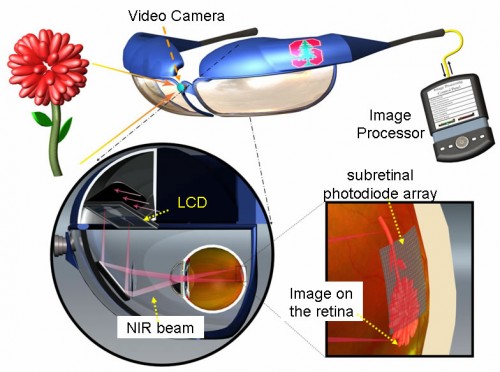
A schematic of the prosthetic vision system developed by Daniel Palanker. (Courtesy: Daniel Palanker)
By Margaret Harris at the AAAS meeting in San Jose
“Restoration of sight to the blind” is a brave claim, one with an almost Biblical ring to it. For Daniel Palanker, though, it is beginning to look as if it is an achievable goal. A medical physicist at the University of Stanford, Palanker has developed a prosthetic vision system that replaces damaged photoreceptors in the retina with an array of tiny photodiodes. When infrared images are projected onto this array, the photodiodes convert the light pulses into electrical signals, which are then picked up by the neurons behind the retina and transmitted to the brain. The result is an artificially induced visual response that, while not as good as normal vision, could nevertheless provide “highly functional restoration of sight” to people with conditions such as retinitis pigmentosa or age-related macular degeneration (AMD).
Speaking at the annual meeting of the American Association for the Advancement of Science (AAAS) in San Jose, California, Palanker explained that when his system was tested on blind rats, the animals had around half of their normal visual acuity restored. In the human eye, that corresponds to a visual acuity of 20/250 – meaning that someone using the system would be able to see objects at a distance of 20 feet that someone with normal vision could see at 250 feet. A French company, Pixium Vision, plans to conduct human clinical trials beginning in 2016; if these prove successful, Palanker, who is also a consultant at Pixium, predicts that an improved version of the technology could give people with certain types of visual impairment up to 20/120 vision. That’s not perfect, he says, but “it is much better than nothing, much better than blindness”. The threshold of legal blindness in the US, he adds, is 20/200.
Palanker’s system does have some drawbacks. It does not restore colour vision – Palanker says that users would probably see the world through a yellowish or bluish haze – and implanting the photovoltaic arrays in the retina would, of course, require surgery. Even so, he argues that his system represents a significant improvement over rival technologies built by Second Sight and Retina Implant, both of which require bulky implanted electronics and cables running under the skin. Users of Palanker’s system, in contrast, would just need to wear a head-mounted camera and video goggles – similar to Google Glass, perhaps. Using non-visible light to project images is also an advantage, Palanker says, because it means that partially sighted people won’t experience conflicting inputs from the photodiodes and their remaining natural photoreceptors. That’s particularly important for people with AMD, since the condition usually strikes photoreceptors at the centre of the field of vision first, leaving peripheral vision substantially intact.
AMD affects around 30% of people over the age of 75, so with an aging global population, a prosthetic vision system such as this one can’t come soon enough. In the more distant future, though, Palanker thinks that his technology could also help people who are born blind – comparable to the way that cochlear implants are now being used to treat children born with deafness. If that happens, scientists truly will be in a position to “make the blind to see”.
Trackback: Physics Viewpoint | A sight for blind eyes
Trackback: Blog - physicsworld.com